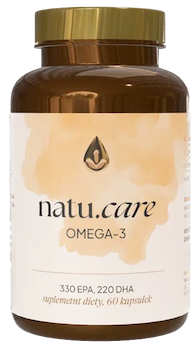- Home
- Omega acids
- Sources of omega-3
Products rich in omega-3 fatty acids - where are they most abundant?
Find out the best sources of omega-3 fatty acids in your diet and make sure you have them on your menu.


Learn more about our editorial process
.

Learn more about our editorial process
.

Learn more about our editorial process
.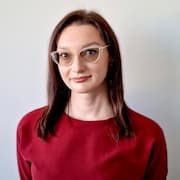

Learn more about our editorial process
.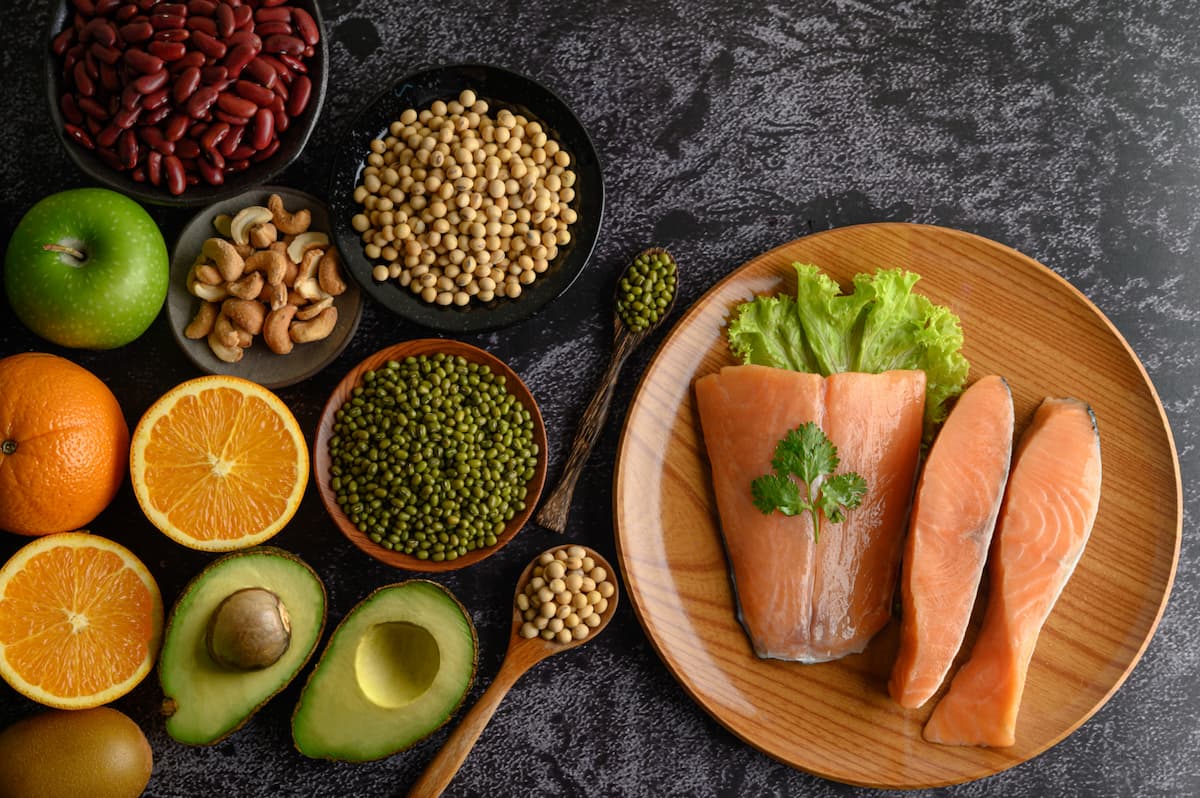
Why you can trust us
Articles on Natu.Care are written based on scientific research, data from government websites and other reliable sources. The texts are written in cooperation with doctors, nutritionists and other health and beauty experts. Articles are reviewed before publication and during significant updates.
.Learn more about our editorial process
.Information about advertisements
Content on Natu.Care may contain links to products from the sale of which we may receive a commission. When creating content, we adhere to high editorial standards and take care to be objective about the products discussed. The presence of affiliate links is not dictated by our partners, and we select the products we review ourselves completely independently.
.Learn more about our terms and Conditions
.Omega-3 fatty acids are essential for your body to function properly. The official recommendation is to consume 250 mg of EPA and DHA per day - but how are you supposed to know how many grams of salmon or tablespoons of chia seeds that is?"
With nutritionist and trainer Marta Kaczorek, we'll tell you what the best sources of omega-3 fatty acids are and how to deliciously incorporate them into your menu. And if you don't eat fish, you will learn why supplementation is necessary.
From this article you will learn:
- Where to find the most omega-3 fatty acids in food.
- Where to find the most omega-3 fatty acids in food.
- How much omega-3 fatty acids are contained in specific foods.
- Why vegans are the most omega-3 fatty acids.
- Why vegans should supplement with omega-3 fatty acids.
- Why vegans should supplement with omega-3 fatty acids.

Sprawdź, za co pokochały go tysiące klientek Natu.Care Premium Omega-3ᵀᴳ -15% z kodem BLOG15
Natu.Care Omega-3ᵀᴳ Premium
Natu.Care Omega-3ᵀᴳ Premium dla zdrowia serca, mózgu i odporności. Najlepsza przyswajalność. Optymalna dawka 750 mg. Przebadana przez niezależne laboratorium.
Zobacz więcej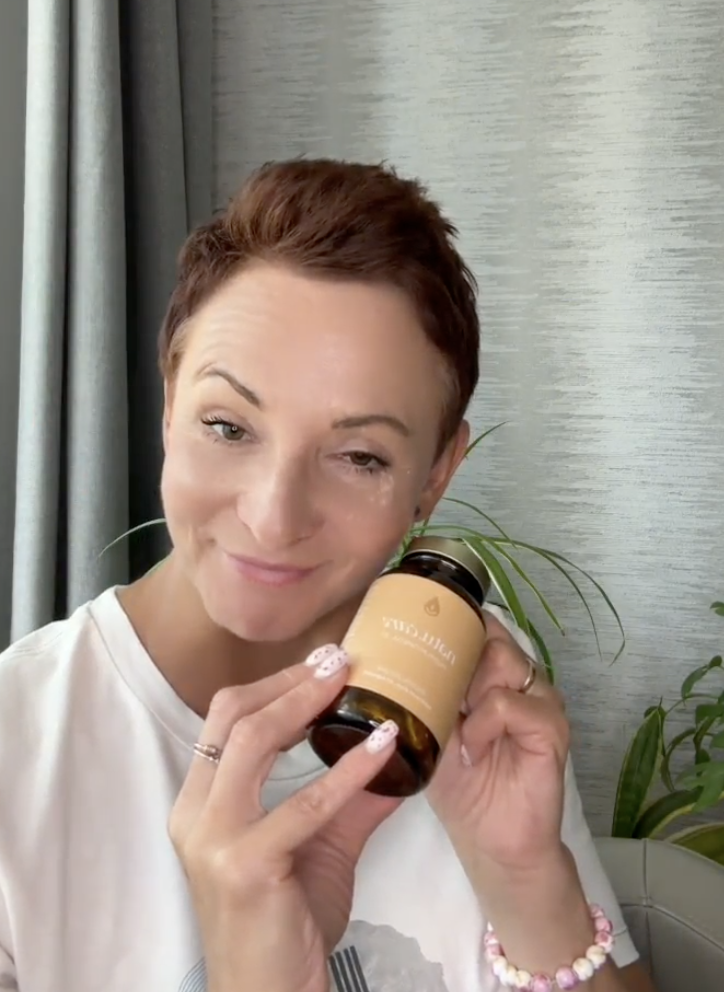
Produkt ma super skład, transparentną etykietę i co dla mnie jest ważne – małe kapsułki do połknięcia. Nie ma też nieprzyjemnego efektu odbijania rybą, który miałam spożywając inne produkty. Widzę znaczną poprawę odporności. Polecam!@Kasia P.
See also:
.- Guide: how to choose omega-3 acids? .
- Omega-3 deficiency: 5 symptoms
- Omega-3 fatty acids
- Omega-6 fatty acids
- Omega-9 fatty acids
- Omega 3-6-9 acids .
- triglycerides of omega-3 fatty acids .
Omega-3 fatty acids - where are they most abundant?
.Most omega-3 fatty acids are found in oily marine fish (e.g. mackerel, sardine, salmon), vegetable oils, nuts, chia seeds, flaxseed. Animal sources of omega-3 contain mainly DHA and EPA acids. They are also better absorbed than plant sources - rich especially in ALAand.
The key to balancing omega acids in the body is to get them from a variety of sources, so it is worth ensuring that both animal and plant products are present in the menu. It also makes it much tastier.
.Omega-3 content of products - table
.In the following animal and plant products you will find healthy omega-3 fats, namely EPA, DHA and ALA acidsand. Each product contains them in different proportions, which is why variety in the diet is so important.
The content of omega-3 fatty acids in these foods can vary depending on a number of factors, such as how they were grown or how they were cooked.
|
Product . |
Content of omega-3 fatty acids in 100 g* |
|
Flaxseed . |
7000-7200 mg |
|
Caviar |
6300-6540 mg |
|
Flaxseed oil |
5300-6000 mg |
|
Chia seeds (chia seeds) . |
5000-6000 mg |
|
Macre³ |
3000-4000 mg |
|
Walnut |
2500-3000 mg |
|
Sardines |
2200-2500 mg |
|
Cod liver oil (tran) |
2000-2400 mg . |
|
Salmon |
2100 mg |
|
Sardelle |
2053 mg |
|
Herring |
2000-3200 mg |
|
Salmon trout |
1200-1400 mg . |
|
Tuna |
1000-1500 mg |
|
Shrimp |
300-500 mg |
|
Ostryga |
391 mg |
Are you vege? Look out for the source
.As you can see, it's not just fish that is rich in valuable healthy fats. Does this mean that if you eat two tablespoons of flaxseed a day (about 20 g, or as much as 1,400 mg of omega-3), you don't have to eat fish you don't like, for example? Unfortunately not.
Remember
There are 3 main types of omega-3 fatty acids. Animal sources primarily contain eicosapentaenoic (EPA) and docosahexaenoic (DHA) acids, while plant sources are rich in alpha-lipoic acid (ALA)and. Consuming plant sources alone is therefore somewhat 'treacherous'. - they will not provide you with enough EPA and DHA.
Also, plant sources of omega-3 are not as well absorbed and utilised by the body as animal sourcesand. The key to balancing all omega acids in the body is therefore to get them from various sources or consider supplementation if you don't eat fish.
Eating plant sources of omega-3 fatty acids mainly provides ALA acids, which are converted to EPA and DHA acids, and by being too poor to provide us with our full daily intake of these acids, the supply of ALA sources from plants needs to be increased..
 .
.
Marta Kaczorek clinical nutritionist and personal trainer
The supply of linoleic acid (LA) should be reduced at the same time, as the same enzymes are needed to convert it as ALA, so it needs to have a large supply of enzymes if we want the process to be most effective, adds the nutritionist.
The diet should also be reduced.
It is recommended that dietary ALA intake should be around 0.5% in the daily ration (i.e. 1g in an 1800 kcal diet). To meet this, you can eat something from this list during the day:
- 5 g flaxseed, .
- 2 g flaxseed oil, .
- 5 g chia seeds, .
- 11 g rapeseed oil, .
- 11 g walnuts, .
Any amount eaten above this will provide even more ALA, and this will give greater conversion to EPA and DHA..
 .
.
Marta Kaczorekclinical nutritionist and personal trainer
Fish with mercury? No thanks
.Many people give up eating fish, for fear of heavy metal contamination. Is that right? Yes, but (my favourite) it depends.
Pay attention to what fish you eat. There are fish that are extremely rich in mercury or lead, but also some that will be safe for you to eat. The Marine Institute of Fisheries (MIR) has indicated how much of certain fish species an adult can eat per week not to exceed the provisional tolerable weekly intake (PTWI) of mercury and dioxinsand.
Below is an example of a summary of common fish in the diet of Poles and their maximum safe weekly intake .
.|
Species of fish . |
Maximum quantity due to mercury |
Maximum quantity due to dioxins + DL-PCB . |
|
Baltic Sea Cod |
2370 g |
950 g |
|
Baltic herring |
1700 g |
400 g |
|
Trout |
2040 g |
2500 g |
|
Smoked Baltic salmon |
1580 g |
75 g |
|
Smoked Norwegian salmon |
2800 g |
570 g |
|
Carp |
3000 g |
7000 g |
|
Smoked mackerel |
2235 g |
1170 g |
|
Tuna in oil |
1670 g |
2510 g |
Blacklist
The most contaminated fish are: butterfish, panga, swordfish, shark, tilapia, eeland.
Fish like mackerel, sardines and trout will mainly provide you with EPA, while salmon, tuna, halibut are rich more in DHA. To ensure you get 250 mg of EPA and DHA per day, you only need to eat 61 grams of salmon per week..
 .
.
Marta Kaczorek clinical nutritionist and personal trainer
Omega-3 in practice
.In order to provide yourself with adequate amounts of omega-3 fatty acids, the official recommendation is to consume 1-2 portions (approximately 300 g) of oily fish per week. Fish is a rich source of DHA and EPA, which you need and you need to provide them to your body from your dietand.
Vegetable sources are rich in ALA acid, but that's not the only valuable thing about them. Chia seeds, for example, are easily digestible, contain fibre and support proper digestive function. It is worth eating around 2 tablespoons of them a day, adding them to yoghurt or oatmeal..
 .
.
Marta Kaczorekclinical nutritionist and personal trainer
Product description
The dietary supplement contains omega-3ᵀᴳ, or omega-3 acids in the form of trójglyceridesów. Scientific studies suggest that this form of fatty acidsós up to 2 times better absorbed than the estersós present in many dietary supplements on the market. This means that you are assured of their effectiveness and of supplying yourself with valuable omega acids.
Fatty acids omega-3 are derived from wild anchovy oil. It is a rich source of healthy fats that are essential for the health of the cardiovascular, immune and nervous systems, as well as the proper function of vision, joints muscles.
Scientific research suggests that wild anchovies are a good source of healthy fats.
Scientific research also suggests that an adequate intake of omega-3 fatty acidsós protects against and supports the treatment of depression and anxiety disorders. In addition, omega-3s influence the hydration and appearance of the skinóry and support healthy sleep.
.
The formula contains a total of 750 mg of EPA+DHA acidsós, which is three times higher than the recommended minimum of 250 mg for the Polish population. Omega-3 TG Premium has studies indicating that its TOTOX is 9, which is a very good result.
Supplementation of omega-3 fatty acidsóis recommended for anyone who does not eat 1–2 portions (approximately 300 g) of oily fish per week. Children during growth, seniors, physically active people, vegans and vegetarians, as well as patients undergoing cardiovascular treatment and prevention of heart disease also have an increased need.
Pros and cons
The dietary supplement contains omega-3ᵀᴳ, or omega-3 acids in the form of trójglyceridesów. Scientific studies suggest that this form of fatty acidsós up to 2 times better absorbed than the estersós present in many dietary supplements on the market. This means that you are assured of their effectiveness and of supplying yourself with valuable omega acids.
Fatty acids omega-3 are derived from wild anchovy oil. It is a rich source of healthy fats that are essential for the health of the cardiovascular, immune and nervous systems, as well as the proper function of vision, joints muscles.
Scientific research suggests that wild anchovies are a good source of healthy fats.
Scientific research also suggests that an adequate intake of omega-3 fatty acidsós protects against and supports the treatment of depression and anxiety disorders. In addition, omega-3s influence the hydration and appearance of the skinóry and support healthy sleep.
.
The formula contains a total of 750 mg of EPA+DHA acidsós, which is three times higher than the recommended minimum of 250 mg for the Polish population. Omega-3 TG Premium has studies indicating that its TOTOX is 9, which is a very good result.
Supplementation of omega-3 fatty acidsóis recommended for anyone who does not eat 1–2 portions (approximately 300 g) of oily fish per week. Children during growth, seniors, physically active people, vegans and vegetarians, as well as patients undergoing cardiovascular treatment and prevention of heart disease also have an increased need.
Additional information
The dietary supplement contains omega-3ᵀᴳ, or omega-3 acids in the form of trójglyceridesów. Scientific studies suggest that this form of fatty acidsós up to 2 times better absorbed than the estersós present in many dietary supplements on the market. This means that you are assured of their effectiveness and of supplying yourself with valuable omega acids.
Fatty acids omega-3 are derived from wild anchovy oil. It is a rich source of healthy fats that are essential for the health of the cardiovascular, immune and nervous systems, as well as the proper function of vision, joints muscles.
Scientific research suggests that wild anchovies are a good source of healthy fats.
Scientific research also suggests that an adequate intake of omega-3 fatty acidsós protects against and supports the treatment of depression and anxiety disorders. In addition, omega-3s influence the hydration and appearance of the skinóry and support healthy sleep.
.
The formula contains a total of 750 mg of EPA+DHA acidsós, which is three times higher than the recommended minimum of 250 mg for the Polish population. Omega-3 TG Premium has studies indicating that its TOTOX is 9, which is a very good result.
Supplementation of omega-3 fatty acidsóis recommended for anyone who does not eat 1–2 portions (approximately 300 g) of oily fish per week. Children during growth, seniors, physically active people, vegans and vegetarians, as well as patients undergoing cardiovascular treatment and prevention of heart disease also have an increased need.
Expert opinion
The dietary supplement contains omega-3ᵀᴳ, or omega-3 acids in the form of trójglyceridesów. Scientific studies suggest that this form of fatty acidsós up to 2 times better absorbed than the estersós present in many dietary supplements on the market. This means that you are assured of their effectiveness and of supplying yourself with valuable omega acids.
Fatty acids omega-3 are derived from wild anchovy oil. It is a rich source of healthy fats that are essential for the health of the cardiovascular, immune and nervous systems, as well as the proper function of vision, joints muscles.
Scientific research suggests that wild anchovies are a good source of healthy fats.
Scientific research also suggests that an adequate intake of omega-3 fatty acidsós protects against and supports the treatment of depression and anxiety disorders. In addition, omega-3s influence the hydration and appearance of the skinóry and support healthy sleep.
.
The formula contains a total of 750 mg of EPA+DHA acidsós, which is three times higher than the recommended minimum of 250 mg for the Polish population. Omega-3 TG Premium has studies indicating that its TOTOX is 9, which is a very good result.
Supplementation of omega-3 fatty acidsóis recommended for anyone who does not eat 1–2 portions (approximately 300 g) of oily fish per week. Children during growth, seniors, physically active people, vegans and vegetarians, as well as patients undergoing cardiovascular treatment and prevention of heart disease also have an increased need.
Product description
The dietary supplement contains high-quality fatty acids omega-3 from anchovy oil. It is a naturally rich source of healthy fats that are essential for cardiovascular, immune and nervous system health, as well as proper function of eyesight, joints muscles.
Scientific research also suggests that an adequate intake of omega-3 fatty acidsós protects against and supports the treatment of depression and anxiety disorders. In addition, omega-3s influence the hydration and appearance of the skinóry and support healthy sleep.
.
The dietary supplement contains 550 mg EPA+DHA per daily serving. This is more than double the official recommendations for the Polish population, whichóre suggesting an intake of at least 250 mg per day.
Supplementation of EPA+DHA is a good way to support healthy sleep.
Supplementation with omega-3 fatty acidsós is advisable if you do not consume 1–2 portions (approx. 300 g) of oily fish per week. There is also an increased need for physically active people, vegans and vegetarians, seniors, children during growth spurts and patients undergoing cardiovascular treatment and prevention of heart disease.
Pros and cons
The dietary supplement contains high-quality fatty acids omega-3 from anchovy oil. It is a naturally rich source of healthy fats that are essential for cardiovascular, immune and nervous system health, as well as proper function of eyesight, joints muscles.
Scientific research also suggests that an adequate intake of omega-3 fatty acidsós protects against and supports the treatment of depression and anxiety disorders. In addition, omega-3s influence the hydration and appearance of the skinóry and support healthy sleep.
.
The dietary supplement contains 550 mg EPA+DHA per daily serving. This is more than double the official recommendations for the Polish population, whichóre suggesting an intake of at least 250 mg per day.
Supplementation of EPA+DHA is a good way to support healthy sleep.
Supplementation with omega-3 fatty acidsós is advisable if you do not consume 1–2 portions (approx. 300 g) of oily fish per week. There is also an increased need for physically active people, vegans and vegetarians, seniors, children during growth spurts and patients undergoing cardiovascular treatment and prevention of heart disease.
Additional information
The dietary supplement contains high-quality fatty acids omega-3 from anchovy oil. It is a naturally rich source of healthy fats that are essential for cardiovascular, immune and nervous system health, as well as proper function of eyesight, joints muscles.
Scientific research also suggests that an adequate intake of omega-3 fatty acidsós protects against and supports the treatment of depression and anxiety disorders. In addition, omega-3s influence the hydration and appearance of the skinóry and support healthy sleep.
.
The dietary supplement contains 550 mg EPA+DHA per daily serving. This is more than double the official recommendations for the Polish population, whichóre suggesting an intake of at least 250 mg per day.
Supplementation of EPA+DHA is a good way to support healthy sleep.
Supplementation with omega-3 fatty acidsós is advisable if you do not consume 1–2 portions (approx. 300 g) of oily fish per week. There is also an increased need for physically active people, vegans and vegetarians, seniors, children during growth spurts and patients undergoing cardiovascular treatment and prevention of heart disease.
Expert opinion
The dietary supplement contains high-quality fatty acids omega-3 from anchovy oil. It is a naturally rich source of healthy fats that are essential for cardiovascular, immune and nervous system health, as well as proper function of eyesight, joints muscles.
Scientific research also suggests that an adequate intake of omega-3 fatty acidsós protects against and supports the treatment of depression and anxiety disorders. In addition, omega-3s influence the hydration and appearance of the skinóry and support healthy sleep.
.
The dietary supplement contains 550 mg EPA+DHA per daily serving. This is more than double the official recommendations for the Polish population, whichóre suggesting an intake of at least 250 mg per day.
Supplementation of EPA+DHA is a good way to support healthy sleep.
Supplementation with omega-3 fatty acidsós is advisable if you do not consume 1–2 portions (approx. 300 g) of oily fish per week. There is also an increased need for physically active people, vegans and vegetarians, seniors, children during growth spurts and patients undergoing cardiovascular treatment and prevention of heart disease.
ALLNUTRITION Omega 3 Strong
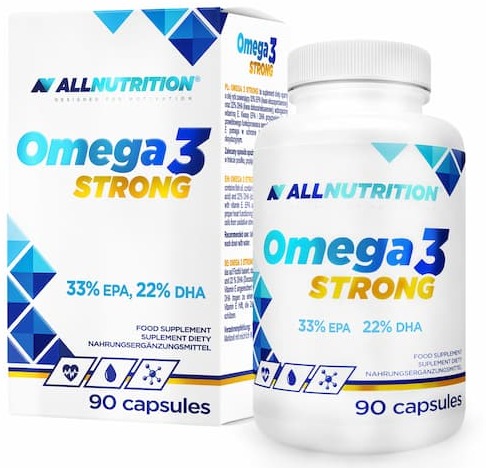
- Content omega-3 acids: 550 mg (DHA 220 mg + EPA 330 mg)
- Additional active ingredients: vitamin E
- Form: capsules .
- Dose: 1 capsule per day .
- Sufficient for: 90 days .
Product description
A dietary supplement with a solid portion of DHA and EPA – valuable for health and well-being omega-3 acidsós. Indicated especially for people on a plant-based diet, physically active people and seniors.
.The sourceóof omega-3 acids in this preparation is fish oil.
.Pros and cons
A dietary supplement with a solid portion of DHA and EPA – valuable for health and well-being omega-3 acidsós. Indicated especially for people on a plant-based diet, physically active people and seniors.
.The sourceóof omega-3 acids in this preparation is fish oil.
.Additional information
A dietary supplement with a solid portion of DHA and EPA – valuable for health and well-being omega-3 acidsós. Indicated especially for people on a plant-based diet, physically active people and seniors.
.The sourceóof omega-3 acids in this preparation is fish oil.
.User review
A dietary supplement with a solid portion of DHA and EPA – valuable for health and well-being omega-3 acidsós. Indicated especially for people on a plant-based diet, physically active people and seniors.
.The sourceóof omega-3 acids in this preparation is fish oil.
.Solgar Omega 3-6-9

- Content of omega acids:.
- Omega-3 fatty acids.
- Omega-3 fatty acids
- alpha-linolenic acid (ALA) – 585 mg
.- eicosapentaenoic acid (EPA) – 344 mg
- docosahexaenoic acid (DHA) – 221 mg
.
- Omega-3 fatty acids
- Omega-6 fatty acids.
- linoleic acid (LA) – 598 mg .
- gamma-linolenic acid (GLA) – 274 mg .
- Omega-9 fatty acids.
- Oleic acid – 325 mg .
- Omega-3 fatty acids.
- Source of omega acids: fish oil from anchovies, mackerel, sardines, linseed oil, cucumber oil .
- Form: capsules .
- Packaging: 60 capsules .
- Daily allowance:3 capsules per day .
- Sufficient for: 20 days .
Product description
A combination of omega 3-6-9 fatty acidsós derived from fish and plants. The dietary supplement supplements essential omega fatty acids, whichóre needed for the proper functioning of many systemsóorgansóin the body.
Pros and cons
A combination of omega 3-6-9 fatty acidsós derived from fish and plants. The dietary supplement supplements essential omega fatty acids, whichóre needed for the proper functioning of many systemsóorgansóin the body.
Additional information
A combination of omega 3-6-9 fatty acidsós derived from fish and plants. The dietary supplement supplements essential omega fatty acids, whichóre needed for the proper functioning of many systemsóorgansóin the body.
A combination of omega 3-6-9 fatty acidsós derived from fish and plants. The dietary supplement supplements essential omega fatty acids, whichóre needed for the proper functioning of many systemsóorgansóin the body.
Omega + Vitamin D3 800 IU for children

- Content of omega-3 fatty acids: 300 mg (180 mg EPA + 120 mg DHA)
- .
- Additional active ingredients: vitamin D3
- Form: twist-off capsules
- .
- Dose: 1 capsule per day
- .
- Sufficient for: 60 days
- .
Product description
Omega-3 acids for children with added vitamin D3 in good doses. The formula fills the daily requirement of EPA and DHA and vitamin D for children aged 2–18 years.
The Ministry of Health recommends supplementation with vitamin D3. In turn, omega-3 fatty acids are also crucial for the youngest.
The dietary supplement from Aura Herbals supports mós brain function, proper vision and immune system function.
The omega-3 fatty acids are derived from fish oil sourced from anchovies.
Pros and cons
Omega-3 acids for children with added vitamin D3 in good doses. The formula fills the daily requirement of EPA and DHA and vitamin D for children aged 2–18 years.
The Ministry of Health recommends supplementation with vitamin D3. In turn, omega-3 fatty acids are also crucial for the youngest.
The dietary supplement from Aura Herbals supports mós brain function, proper vision and immune system function.
The omega-3 fatty acids are derived from fish oil sourced from anchovies.
Additional information
Omega-3 acids for children with added vitamin D3 in good doses. The formula fills the daily requirement of EPA and DHA and vitamin D for children aged 2–18 years.
The Ministry of Health recommends supplementation with vitamin D3. In turn, omega-3 fatty acids are also crucial for the youngest.
The dietary supplement from Aura Herbals supports mós brain function, proper vision and immune system function.
The omega-3 fatty acids are derived from fish oil sourced from anchovies.
User review
Omega-3 acids for children with added vitamin D3 in good doses. The formula fills the daily requirement of EPA and DHA and vitamin D for children aged 2–18 years.
The Ministry of Health recommends supplementation with vitamin D3. In turn, omega-3 fatty acids are also crucial for the youngest.
The dietary supplement from Aura Herbals supports mós brain function, proper vision and immune system function.
The omega-3 fatty acids are derived from fish oil sourced from anchovies.
Preparations rich in omega-3 fatty acids
.Dietitian Marta Kaczorek pampers her clients' palates with delicious recipes, and when you need to supply omega-3 fatty acids - she suggests these nutritious dishes:
Salmon with mango salsa
.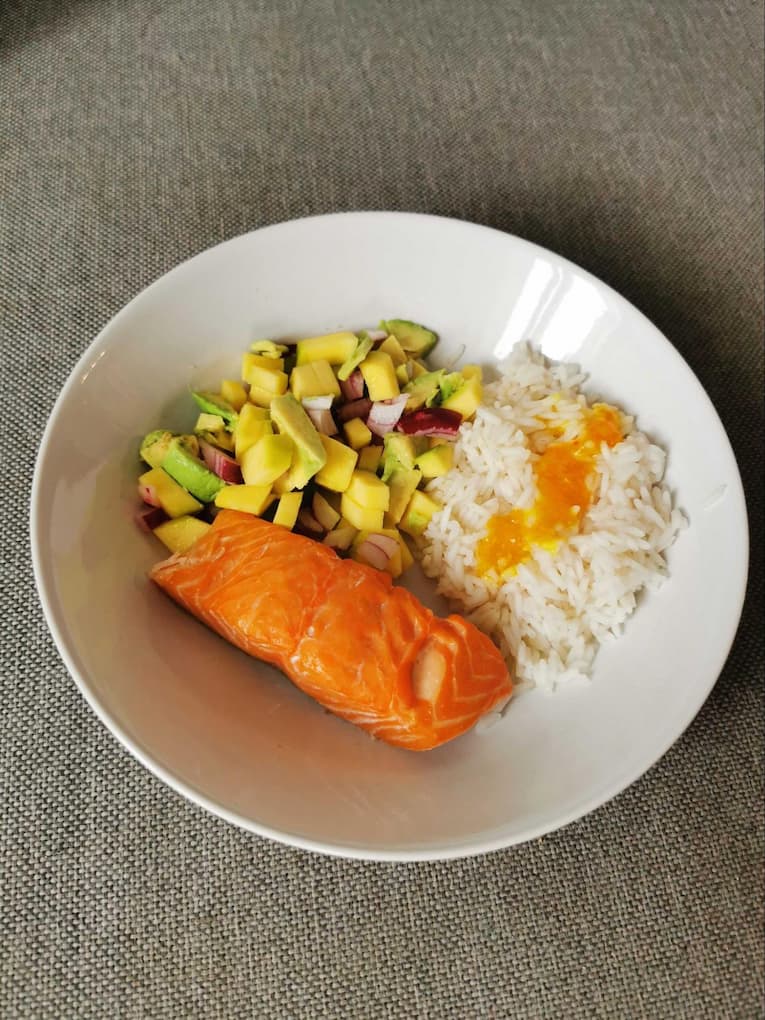
Ingredients for 1 serving:
.- avocado 50 g (1/3 piece) .
- beef, fresh 80 g (1/3 piece) .
- ginger root, raw 1 g (1/8 piece) .
- xylitol 7 g (1 teaspoon) .
- ground turmeric 1 g (1/4 teaspoon) .
- mango 100 g (1/4 piece) .
- potato flour 5 g (1/5 tsp) .
- bees honey 10 g (1/3 tsp) .
- canola oil 10 ml (1 tbsp) .
- chili pepper 2 g (1/8 piece) .
- black pepper 1 g (1 pinch) .
- white salt 1 g (1 pinch) .
- parsley leaves 6 g (1 teaspoon) .
- orange juice 50 ml (1/5 cup) .
- lime juice 3 ml (1/2 tsp) .
- shallots 40 g (2 pieces) .
- jasmine rice 40 g (1/5 cup) .
Making:
- Mango and avocado salsa: Wash the mango, peel it and separate the flesh from the seed. Dice it and put it in a salad bowl. Wash, peel and halve the avocado. Remove the stone and dice the flesh, add to the bowl, drizzle with lime juice and add the chopped shallots. Mix, sprinkle with parsley and set aside. .
- Orange-ginger sauce: Pour the rapeseed oil into a saucepan. Slice the chilli peppers (removing the seeds beforehand). Peel and finely grate the ginger and onion. Place the peppers, ginger and onion in a saucepan and sauté, stirring, for about a minute. Add the turmeric, orange juice mixed with the potato flour and honey and cook for 1 minute. .
- Salmon: Rinse and dry the salmon fillet thoroughly, season with salt, rub (skin side down) with turmeric and paprika and then a little oil. Place on a well heated grill pan skin side down. Grill for about 7 minutes on medium power, then turn to the other side and grill for a further 4 minutes. Remove from the pan and place on a plate with the skin side down. Pour the orange-ginger sauce over the salmon. Serve with salsa and rice. .
What good will you provide yourself with?
.Protein 22.36 g, fats 29.10 g (of which omega-3 is 4.13 g), carbohydrates 83.23 g, iron 3.60 mg, folate 119.40 µg, vitamin B12 4.00 µg. A portion has 664 kcal.
.Salad with quinoa
.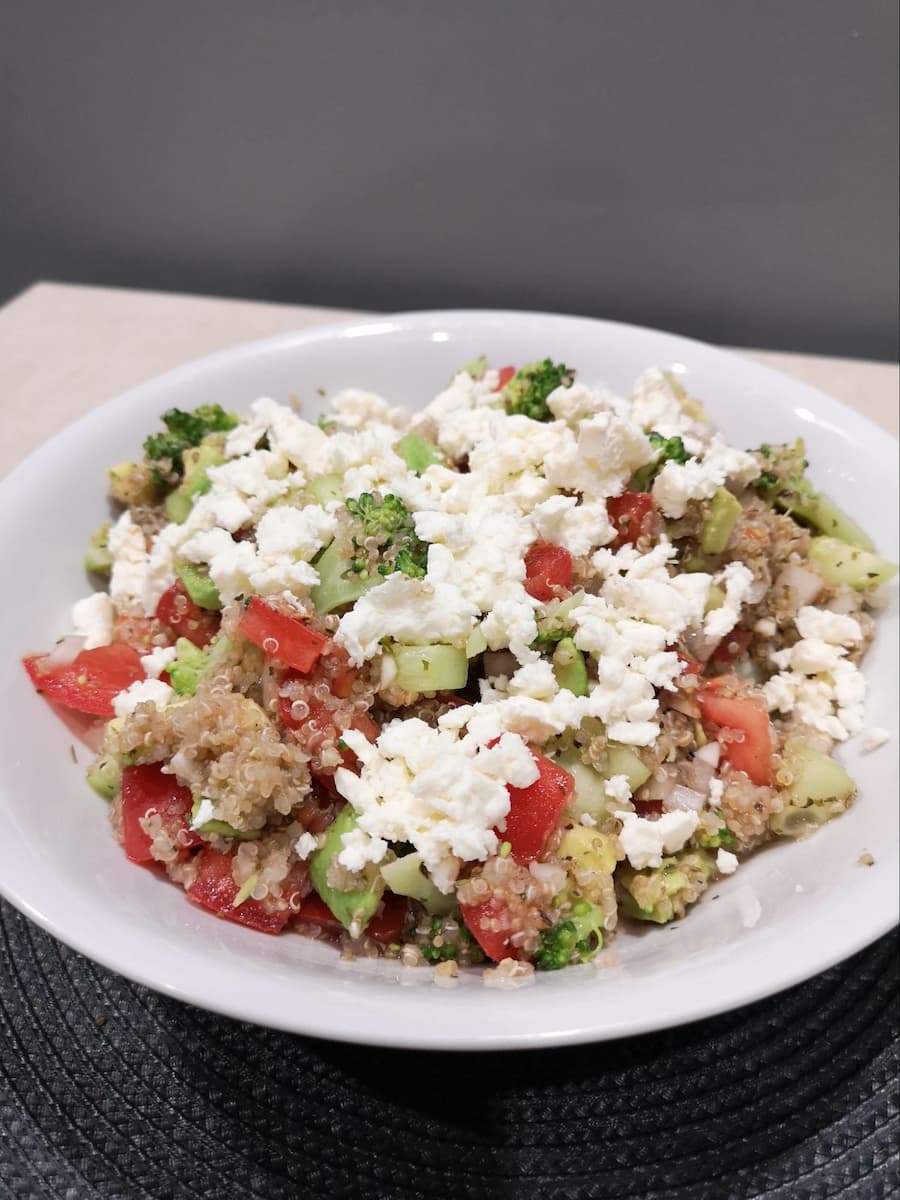
Ingredients for 1 serving:
.- avocado 70 g (1/2 piece) .
- dried basil 1 g (1 teaspoon) .
- broccoli 100 g (1/5 piece) .
- cucumber 50 g (1/2 piece) .
- garlic 5 g (1 clove) .
- rice quinoa 70 g (1/3 cup)
- balsamic vinegar 4 g (2/3 tsp) .
- linseed oil 8 ml (3/4 tsp) .
- dried oregano 1 g (1/3 teaspoon)
- black pepper 1 g (1 pinch) .
- parsley leaves 12 g (2 teaspoons)
- tomato 170 g (1 piece) .
- feta cheese 50 g (1/4 cube) .
- white salt 1 g (1 pinch) .
- cucumber 90 g (1/2 piece) .
Making:
- Cook the quinoa according to the instructions on the packet in lightly salted water.
- Cook the broccoli according to the instructions on the packet in lightly salted water.
- Cook or steam the broccoli. Shred into smaller florets.
- Prepare the broccoli.
- Wash the tomato and cucumber, dice. .
- Peel the avocado, remove the stone and dice. .
- Fine chop the onion and garlic. .
- Pour the quinoa and vegetables into a bowl and make a dressing from the remaining ingredients, which you then add to the salad and mix well. .
- Add the feta cheese cut into cubes. .
What good will you provide yourself with?
.Protein 26.93 g, fat 32.18 g (of which omega-3 is 5.09 g), carbohydrate 74.02 g, iron 8.36 mg, folate 417.29 µg, vitamin B12 0.55 µg. A serving has 675 kcal.
See also:
.Taste also salmon with... collagen
.See Preparations for a fun idea for bowl salmon with collagen sauce!
Why are omega-3 fatty acids important?
.Omega-3 fatty acids are crucial as early as prenatal developmentand. Then, throughout life, they influence the proper functioning of many systems, processes and organs in the body.
Omega-3 fatty acidsand:
- .
- support the function of the nervous, cardiovascular, immune, neurological systems, .
- maintain joint, muscle and bone health, .
- influence brain and vision development in infants, .
- reduce the risk of autoimmune diseases and cancer, .
- affect the appearance of the skin, .
- reduce inflammation in the body, .
- promote healthy sleep, .
- improve the performance of the body, .
- reduce the risk of depression and anxiety disorders.

Sprawdź, za co pokochały go tysiące klientek Natu.Care Premium Omega-3ᵀᴳ -15% z kodem BLOG15
Natu.Care Omega-3ᵀᴳ Premium
Natu.Care Omega-3ᵀᴳ Premium dla zdrowia serca, mózgu i odporności. Najlepsza przyswajalność. Optymalna dawka 750 mg. Przebadana przez niezależne laboratorium.
Zobacz więcej
Produkt ma super skład, transparentną etykietę i co dla mnie jest ważne – małe kapsułki do połknięcia. Nie ma też nieprzyjemnego efektu odbijania rybą, który miałam spożywając inne produkty. Widzę znaczną poprawę odporności. Polecam!@Kasia P.
See also:
.- Omega-3 medicine, not a supplement .
- Guide: How to choose omega-3 acids? .
- The best omega-3s in capsules
- Omega-3 for children
Summary
.- Omega-3 fatty acids are DHA, EPA and ALA acids.
- They are the most important omega-3 fatty acids.
- They are found in plant and animal products in different proportions.
- They are also found in plant and animal products in different proportions.
- Fatty marine fish are the richest and best absorbed source of DHA and EPA, and plants (oils, seeds, seeds) contain the most ALA. .
- You should eat a minimum of 250 mg EPA + DHA per day, i.e. 1-2 servings (300 g) of oily fish per week. .
- People who do not eat fish are unable to provide adequate amounts of DHA and EPA from food, so should consider supplementation with omega-3 fatty acids. .
- A recommended dietary supplement with omega-3 fatty acids is Natu.Care Omega-3 TG Premium with highly bioavailable omega-3s in the form of triglycerides.
FAQ
.What are the best omega-3 fatty acids in tablets?
.The recommended supplement with omega-3 fatty acids DHA+EPA is Natu.Care Omega-3 TG Premium with a 500 mg EPA acid and 250 mg DHA acid. Contains highly bioavailable triglycerides. The use of 1 capsule per day supplements the diet with valuable fats and is sufficient for 60 days of supplementation.
What omega-3 fatty acids for children to choose?
The best omega-3 acids for children is Aura Herbals Omega 300 mg + Vitamin D3 800 IU. This is a high-quality dietary supplement with a child-appropriate daily serving of DHA acids, EPA and vitamin D3. The twist-off capsules are easy to administer and the product lasts for up to 60 days.
What are the symptoms of omega-3 fatty acid deficiency?
.Insufficient omega-3 fatty acids in the body can produce the following symptomsand:
- dryness of the skin and eyes, keratosis of the epidermis, .
- joint pains, .
- hair loss, .
- lower mood, .
- fatigue, .
- frequent, recurrent infections, .
What fruits contain omega-3s?
.The richest in omega-3 acids is avocado, with alpha-lipoic acid (ALA) being the most abundant - 261 mg in 100 g of fruit. The fats in avocados are mainly unsaturated fats (oleic acid) with a very good ratio of omega 3 to omega 6.
Is it possible to overdose on omega-3 fatty acids from food?
.It is not possible to overdose on omega-3 fatty acids from food at one time. To do so, you would have to eat several kilograms of oily sea fish. It can be dangerous to your health to over-supplement and take much higher recommended daily portions.
How to supplement with omega-3 fatty acids?
.To supplement the deficiency of omega-3 fatty acids in the body, one should first implement oily marine fish (e.g. salmon, anchovies, mackerel, salmon trout) into the diet. People on vegan and vegetarian diets should supplement with omega-3, as they are unable to obtain them from a plant-based diet.
What is better cod liver oil or shark liver oil?
.There is no such thing as shark oil. Tran is a concentrated oil made only from the liver of Atlantic cod or other fish in the cod family. Shark liver oil is not transshark oil, but oil from the organs of these animals.
Most often such shark oil has more omega-3 fatty acids than cod liver oil, but contains less vitamin A and vitamin D3 or none at all.
Sources
.See all
.Chen, B., & Dong, S. (2022). Mercury Contamination in Fish and Its Effects on the Health of Pregnant Women and Their Fetuses, and Guidance for Fish Consumption-A Narrative Review. International Journal of Environmental Research and Public Health, 19(23), 15929. https://doi.org/10.3390/ijerph192315929
Dyall, S. C. (2015). Long-chain omega-3 fatty acids and the brain: A review of the independent and shared effects of EPA, DPA and DHA. Frontiers in Aging Neuroscience, 7, 52. https://doi.org/10.3389/fnagi.2015.00052
EFSA Panel on Dietetic Products, Nutrition and Allergies (NDA). (2012). Scientific Opinion on the Tolerable Upper Intake Level of eicosapentaenoic acid (EPA), docosahexaenoic acid (DHA) and docosapentaenoic acid (DPA). EFSA Journal, 10(7), 2815. https://doi.org/10.2903/j.efsa.2012.2815
FoodData Central. (n.d.). Retrieved 3 October 2023, from https://fdc.nal.usda.gov/fdc-app.html#/
Ghasemi Fard, S., Wang, F., Sinclair, A. J., Elliott, G., & Turchini, G. M. (2019). How does high DHA fish oil affect health? A systematic review of evidence. Critical Reviews in Food Science and Nutrition, 59(11), 1684-1727. https://doi.org/10.1080/10408398.2018.1425978
Guo, Y., Ma, B., Li, X., Hui, H., Zhou, Y., Li, N., & Xie, X. (2022). Omega-3 Polyunsaturated Fatty Acids Can Reduce IL-6 and TNF Levels in Patients with Cancer. The British Journal of Nutrition, 1-34. https://doi.org/10.1017/S0007114522000575
Kavyani, Z., Musazadeh, V., Fathi, S., Hossein Faghfouri, A., Dehghan, P., & Sarmadi, B. (2022). Efficacy of the omega-3 fatty acids supplementation on inflammatory biomarkers: An umbrella meta-analysis. International Immunopharmacology, 111, 109104. https://doi.org/10.1016/j.intimp.2022.109104
Khalili, L., Valdes-Ramos, R., & Harbige, L. S. (2021). Effect of n-3 (Omega-3) Polyunsaturated Fatty Acid Supplementation on Metabolic and Inflammatory Biomarkers and Body Weight in Patients with Type 2 Diabetes Mellitus: A Systematic Review and Meta-Analysis of RCTs. Metabolites, 11(11), 742. https://doi.org/10.3390/metabo11110742
Kiecolt-Glaser, J. K., Belury, M. A., Andridge, R., Malarkey, W. B., & Glaser, R. (2011). Omega-3 supplementation lowers inflammation and anxiety in medical students: A randomized controlled trial. Brain, Behavior, and Immunity, 25(8), 1725-1734. https://doi.org/10.1016/j.bbi.2011.07.229
Kruger, M. C., Coetzer, H., de Winter, R., Gericke, G., & van Papendorp, D. H. (1998). Calcium, gamma-linolenic acid and eicosapentaenoic acid supplementation in senile osteoporosis. Aging (Milan, Italy), 10(5), 385-394. https://doi.org/10.1007/BF03339885
Leaf, A. (2008). Historical overview of n-3 fatty acids and coronary heart disease. The American Journal of Clinical Nutrition, 87(6), 1978S-80S. https://doi.org/10.1093/ajcn/87.6.1978S
Li, J., Xun, P., Zamora, D., Sood, A., Liu, K., Daviglus, M., Iribarren, C., Jacobs, D., Shikany, J. M., & He, K. (2013). Intakes of long-chain omega-3 (n-3) PUFAs and fish in relation to incidence of asthma among American young adults: The CARDIA study123. The American Journal of Clinical Nutrition, 97(1), 181-186. https://doi.org/10.3945/ajcn.112.041145
Liao, Y., Xie, B., Zhang, H., He, Q., Guo, L., Subramanieapillai, M., Fan, B., Lu, C., & McIntyre, R. S. (2019). Efficacy of omega-3 PUFAs in depression: A meta-analysis. Translational Psychiatry, 9, 190. https://doi.org/10.1038/s41398-019-0515-5
Liu, G., Liu, J., Pian, L., Gui, S., & Lu, B. (2019). α-lipoic acid protects against carbon tetrachloride-induced liver cirrhosis through the suppression of the TGF-β/Smad3 pathway and autophagy. Molecular Medicine Reports, 19(2), 841-850. https://doi.org/10.3892/mmr.2018.9719
Mano, Y., Kato, A., Fukuda, N., Yamada, K., & Yanagimoto, K. (2022). Influence of Ingestion of Eicosapentaenoic Acid-Rich Fish Oil on Oxidative Stress at the Menstrual Phase: A Randomized, Double-Blind, Placebo-Controlled, Parallel-Group Trial. Women's Health Reports, 3(1), 643-651. https://doi.org/10.1089/whr.2022.0003
Marine Oils. (2006). In Drugs and Lactation Database (LactMed®). National Institute of Child Health and Human Development. http://www.ncbi.nlm.nih.gov/books/NBK501898/
Martins, J. G. (2009). EPA but not DHA appears to be responsible for the efficacy of omega-3 long chain polyunsaturated fatty acid supplementation in depression: Evidence from a meta-analysis of randomized controlled trials. Journal of the American College of Nutrition, 28(5), 525-542. https://doi.org/10.1080/07315724.2009.10719785
Merle, B. M. J., Benlian, P., Puche, N., Bassols, A., Delcourt, C., Souied, E. H., & Nutritional AMD Treatment 2 Study Group. (2014). Circulating omega-3 Fatty acids and neovascular age-related macular degeneration. Investigative Ophthalmology & Visual Science, 55(3), 2010-2019. https://doi.org/10.1167/iovs.14-13916
Mohajeri, M. H., Troesch, B., & Weber, P. (2015). Inadequate supply of vitamins and DHA in the elderly: Implications for brain aging and Alzheimer-type dementia. Nutrition (Burbank, Los Angeles County, Calif.), 31(2), 261-275. https://doi.org/10.1016/j.nut.2014.06.016
Montgomery, P., Burton, J. R., Sewell, R. P., Spreckelsen, T. F., & Richardson, A. J. (2014). Fatty acids and sleep in UK children: Subjective and pilot objective sleep results from the DOLAB study--a randomized controlled trial. Journal of Sleep Research, 23(4), 364-388. https://doi.org/10.1111/jsr.12135
Nelson, J. R., Wani, O., May, H. T., & Budoff, M. (2017). Potential benefits of eicosapentaenoic acid on atherosclerotic plaques. Vascular Pharmacology, 91, 1-9. https://doi.org/10.1016/j.vph.2017.02.004
Taslima, K., Al-Emran, M., Rahman, M. S., Hasan, J., Ferdous, Z., Rohani, M. F., & Shahjahan, M. (2022). Impacts of heavy metals on early development, growth and reproduction of fish-A review. Toxicology Reports, 9, 858-868. https://doi.org/10.1016/j.toxrep.2022.04.013
Wawryszuk, N. (2023). Omega acids. Everything you need to know. (B. Turczynski, Ed.; 1st ed.). Natu.Care. https://books.google.com/books?vid=9788396887818
.Editorials
Meet the team


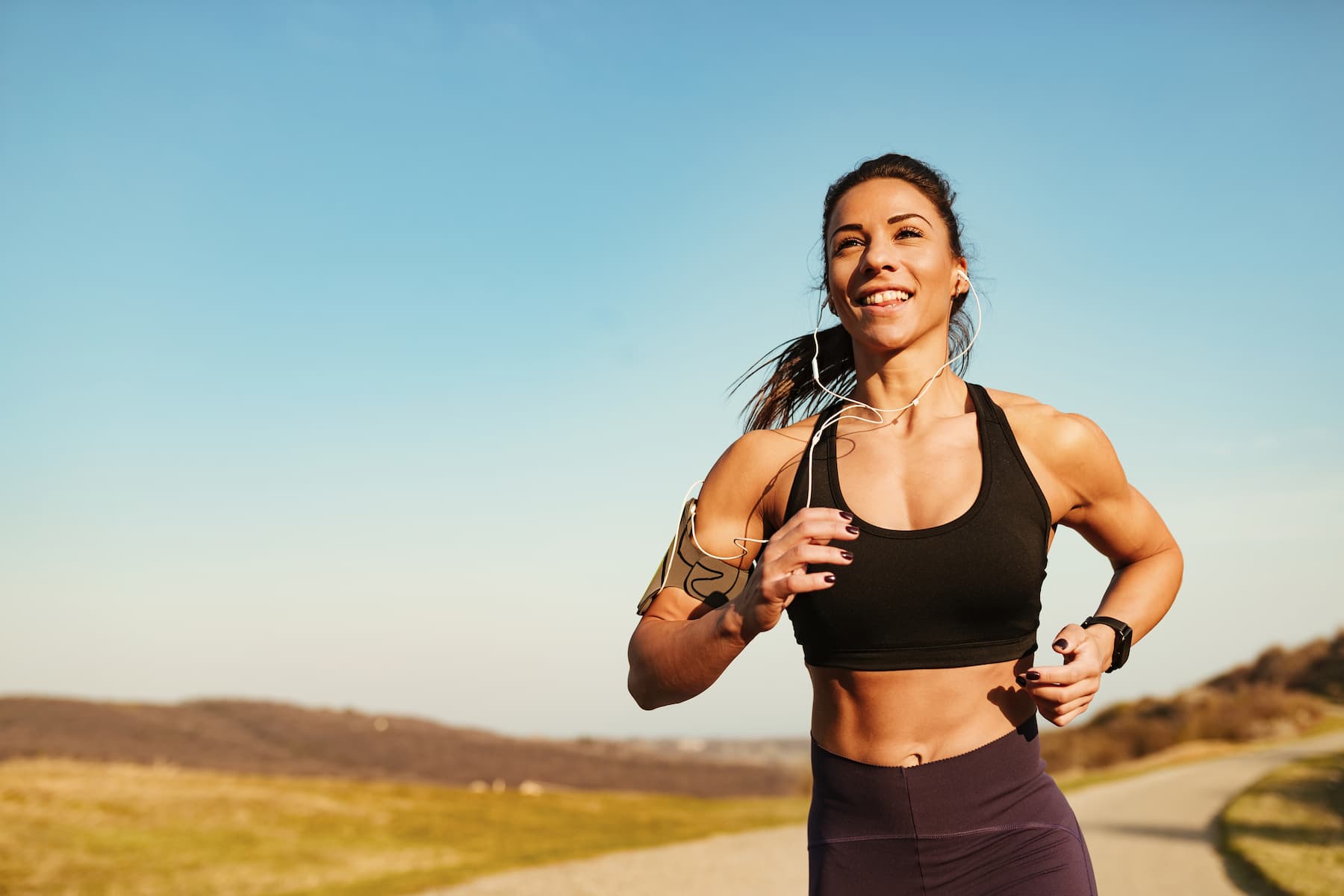
Omega-3 fatty acids are a useful dietary supplement for active people - improves performance and fitness.

Omega-3 in a good dose and an optimum ratio of DHA and EPA acids will replenish valuable fats in the diet.

The omega-3 acids from Natu.Care are distinguished by their triglyceride form, which is characterised by high bioavailability.

